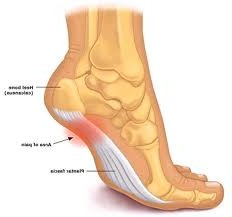PLANTAR FASCIOPATHY / ARCH PAIN
ANATOMY, MECHANISM AND SIGNS & SYMPTOMS
The plantar fascia is a thick sheet of connective tissue (ligament) that supports the arch of the foot. It attaches from the heel bone to the base of the toes. There is a fat pad under the heel where the plantar fascia attaches, and this helps to dampen the load through that insertion point.
Plantar fasciopathy is a general term that describes heel or arch pain as a result of an overuse problem of the plantar fascia.
Initially, in the few days following the original injury, this is inflammatory in nature (plantar fasciitis) and symptoms include intense pain (particularly at the end of the day), heat and swelling. The inflammatory phase usually lasts a few days, unless repetitive loading and overuse of the plantar fascia continue, in which case it may last longer.
If repetitive stress of the plantar fascia continues degeneration usually occurs, including calcification of the plantar fascia near the insertion at the heel. In this case the condition is no longer inflammatory. Pain is likely to be worse when putting weight on your foot after a period of rest (e.g. in the morning) and usually eases after the first few steps.
TREATMENT
Treatment will likely include:
- RICE after injury (Rest, Ice, Compression, Elevation)
- Strapping
- Soft orthotics
- Use of night splints
- Stretches
- Exercises
- Ice
- Massage
- Replacing footwear if necessary
- Acupuncture
- Activity modification




Leave a reply